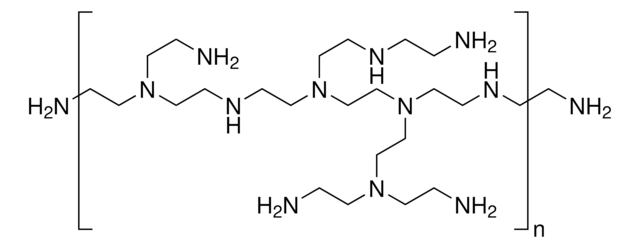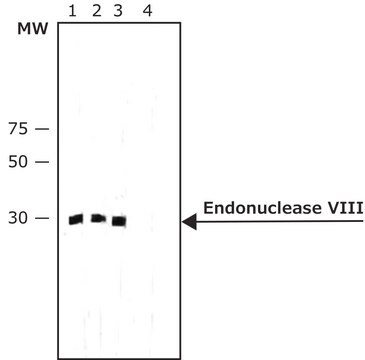AB3639
Anti-Endonuclease G Antibody
Chemicon®, from rabbit
Synonym(s):
EndoG
Sign Into View Organizational & Contract Pricing
Select a Size
All Photos(1)
Select a Size
Change View
About This Item
UNSPSC Code:
12352203
eCl@ss:
32160702
NACRES:
NA.41
Recommended Products
biological source
rabbit
Quality Level
antibody form
affinity purified immunoglobulin
antibody product type
primary antibodies
clone
polyclonal
purified by
affinity chromatography
species reactivity
mouse, rat, human
manufacturer/tradename
Chemicon®
technique(s)
western blot: suitable
NCBI accession no.
Specificity
Recognizes Endonuclease G (EndoG), a mitochondrion-specific nuclease that translocates to the nucleus and cleaves chromatin DNA during apoptosis. EndoG is specifically activated by apoptotic stimuli and is able to induce nucleosomal fragmentation of DNA independently of caspase and DFF/CAD (1,2).
Immunogen
Synthetic peptide corresponding to amino acids 55 to 70 of human EndoG (GGPRGPGELAKYGLP).
Application
Anti-Endonuclease G Antibody is an antibody against Endonuclease G for use in WB.
Research Category
Apoptosis & Cancer
Apoptosis & Cancer
Research Sub Category
Apoptosis - Additional
Apoptosis - Additional
Western blotting (1-2μg/mL)
Optimal working dilutions must be determined by the end user.
Optimal working dilutions must be determined by the end user.
Physical form
Affinity purified immunoglobulin. Liquid in PBS containing 0.02% sodium azide.
Storage and Stability
Maintain at 2-8ºC for 12 months.
Other Notes
Concentration: Please refer to the Certificate of Analysis for the lot-specific concentration.
Legal Information
CHEMICON is a registered trademark of Merck KGaA, Darmstadt, Germany
Disclaimer
Unless otherwise stated in our catalog or other company documentation accompanying the product(s), our products are intended for research use only and are not to be used for any other purpose, which includes but is not limited to, unauthorized commercial uses, in vitro diagnostic uses, ex vivo or in vivo therapeutic uses or any type of consumption or application to humans or animals.
Not finding the right product?
Try our Product Selector Tool.
Storage Class
10 - Combustible liquids
wgk_germany
WGK 2
flash_point_f
Not applicable
flash_point_c
Not applicable
Certificates of Analysis (COA)
Search for Certificates of Analysis (COA) by entering the products Lot/Batch Number. Lot and Batch Numbers can be found on a product’s label following the words ‘Lot’ or ‘Batch’.
Already Own This Product?
Find documentation for the products that you have recently purchased in the Document Library.
L Y Li et al.
Nature, 412(6842), 95-99 (2001-07-14)
Nucleosomal fragmentation of DNA is a hallmark of apoptosis (programmed cell death), and results from the activation of nucleases in cells undergoing apoptosis. One such nuclease, DNA fragmentation factor (DFF, a caspase-activated deoxyribonuclease (CAD) and its inhibitor (ICAD)), is capable
Shuangping Zhao et al.
Journal of neuroscience research, 88(8), 1727-1737 (2010-01-16)
We have shown that generalized seizures produce necrotic neurons with caspase-independent nuclear pyknosis and DNA fragmentation. In this study, we determined the time course of translocation of mitochondrial cytochrome c, apoptosis-inducing factor, endonuclease G, lysosomal cathepsins B and D, and
Caspase-independent pathways of hair cell death induced by kanamycin in vivo
Jiang, H, et al
Cell Death and Differentiation, 13, 20-30 (2006)
Po-Yuan Chen et al.
Evidence-based complementary and alternative medicine : eCAM, 2012, 718320-718320 (2012-08-25)
Phenethyl isothiocyanate (PEITC), an effective anticancer and chemopreventive agent, has been reported to inhibit cancer cell growth through cell-cycle arrest and induction of apoptotic events in various human cancer cells models. However, whether PEITC inhibits human oral squamous cell carcinoma
Mitochondrial endonuclease G is important for apoptosis in C. elegans.
Parrish, J, et al.
Nature, 412, 90-94 (2001)
Our team of scientists has experience in all areas of research including Life Science, Material Science, Chemical Synthesis, Chromatography, Analytical and many others.
Contact Technical Service








